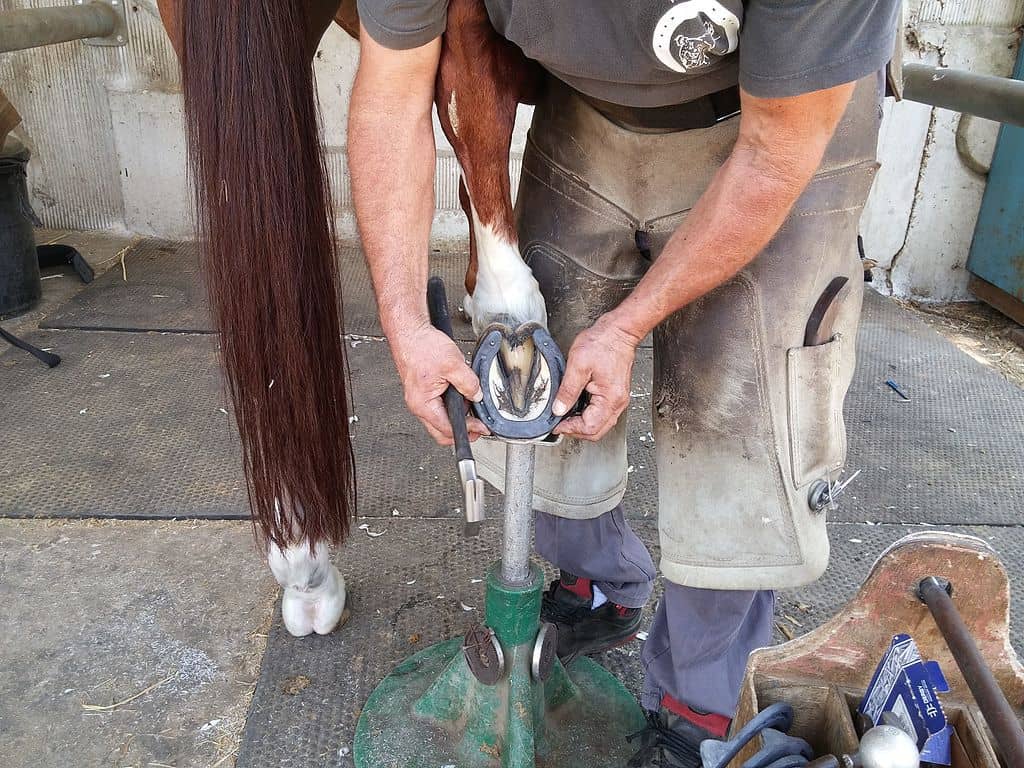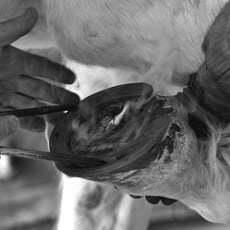Apprenticeships are a farrier’s first real taste of what it’s like to work in the industry. Even if you’ve had a good hands-on education, an apprenticeship will be invaluable for applying what you’ve learned and honing your skills before you need to go out and market yourself. Since there are no regulations for farrier apprenticeships and therefore no formal rules to prevent you from ending up in an unbreakable agreement to 108 hour work weeks in the back end of a swamp pulling shoes from murderous stallions in exchange for “training” that ends up being mostly about survival, here’s some info and suggestions for making your apprenticeship count.
How Much Time Will it Take?
Apprenticeships are flexible. They could be months, or years. That’s something you can discuss with the farrier you want to apprentice with. Most will ask you to stay on for a certain length of time. The American Farriers Journal recently completed a survey of farriers who hire apprentices that gives a pretty good idea of what the average farrier/apprentice relationship looks like. It tells us that the average time established farriers want you to spend in an apprenticeship is 23 months.
How Can You Make the Most of that Time?
Vet Your Mentors. Have a detailed idea of what you want to learn and how you learn best before you commit to an apprenticeship. Backing out is a waste of your time and your mentor’s, so ask lots of questions of lots of farriers so you can find a good match. You can even ask to do a week-long trial to see if your learning/teaching styles, working styles and personalities will mesh.
Be strategic. If there’s a skill you want to learn, make sure your mentor can teach it. Put a learning plan in place so you can master all the component skills that lead up to any advanced work you want to be able to do.
Listen. As an apprentice, you’re there to learn from somebody, which sounds straightforward until you get a bit of confidence and think of new/ different/ better ways to do things that what your mentor is teaching you. Learning someone else’s methods thoroughly, even if you don’t completely agree with them, gives you more expertise than learning two systems (theirs and yours) in a half-assed way. Your ideas will keep. Learn while you can.
What Will You Be Doing?
You’ll be earning trust by proving that you’re competent enough not to mess up the feet of your employer’s hard-earned clients. This will likely be a long and unglamorous process that sees you pulling a lot of shoes. Jeff Cota tells us that the AFJ survey found that “98% of apprentices who have been working full-time for 3 months are pulling shoes. Meanwhile, 95% are allowed to clinch shoes; 93% can sand, coat and polish hooves; and 83% fetch horses.” Only later in the typical apprenticeship does the more advanced work begin.
How Can You Make the Most of What You Do?
Practice. The apprenticeship is a performance based system, so (ideally) the more you master the basics, the more responsibility you can expect to be given. There’s no short cut to perfecting the basics. But the apprenticeship does offer benefits that will help you: equipment you can’t possibly afford as a new farrier, a high number of clients/horses you would otherwise never have access to and a mentor who can fix your mistakes and help pull you out of a hole should you happen to dig yourself one.
Practice with help. This is your last chance as a professional to have steady mentorship. Once you’re out on your own, people will expect you to know your stuff. This is your time to ask every question that comes to you and work on every task you can so you can get feedback on your performance.
Practice what you’re worst at. There’s a strong temptation to show your mentor what you do best so that you don’t look like an idiot in front of them. That’s…actually probably a good strategy to start with, but it’s not the best strategy in the long run. You’ll get more out of your apprenticeship if you focus on your weaknesses and improve them while you have somebody experienced to offer you advice to overcome them.
(What) Will You Get Paid?
You may or not earn a salary as an apprentice. The AFJ’s survey found that apprentices earned “an average daily wage of $112.” For some, that will involve a flat wage for a day’s work or a flat amount per horse, for others a percentage of the income for the day and for others, a combination. Without regulations about whether or how much a farrier’s apprentice should be paid or how many hours s/he should put in, the possibilities will vary widely depending on the individual you want to work with.
How Can you Make the Most of Your Financial Arrangement?
Negotiate. Remembering, of course, that your mentor is not rich and you’re not about to get rich. If you need to take home a certain income, don’t be afraid to say so. If the farrier you want to work with simply doesn’t have enough clients to be able to offer you what you need, s/he will also not be afraid to say so.
Propose incentives, if the farrier you work with doesn’t offer them. Your employer might be game to offer you a percentage or a bonus if you help them reach or go over a specific gross amount per day.
Think about the financial value of experience. Education is an investment. It costs the person teaching you time, which in this profession, is also time that person could have spent just shoeing another horse and making money. Consider the time a farrier spends on you as part of your wage.
Keep an eye on the long haul. Having a strong set of skills, especially if few people can do them, will give you a financial return down the road. Maybe one farrier is offering you a better wage, but another who offers less is also offering to teach you high-demand skills that only s/he knows how to do in your area. Your expertise will earn you your living, so factor that into your decisions about your apprenticeship.
Good luck!
by Cindy McMann
image 1: Wikimedia Commons; image 2: M.Franke (Creative Commons BY)









